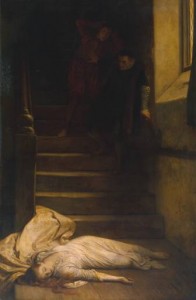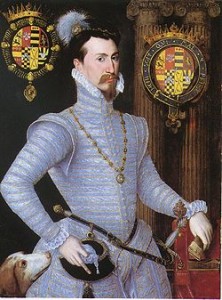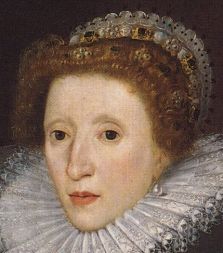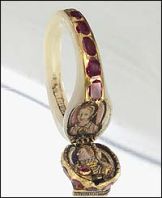Queen Elizabeth I controversies
Jump to navigation
Jump to search
Click EasyEdit to add this page! (Don't see the EasyEdit button above? <a href="../#signin" target="_self">Sign in</a> or <a href="../accountnew" target="_self">Sign up</a>.) |
| What did Elizabeth think of her mother , Anne Boleyn? "Elizabeth referred to her mother several times and from her actions and speech it seems that she viewed her mother in a sympathetic light. What is perhaps most striking is the fact that Elizabeth asked her Archbishop of Canterbury, Matthew Parker, to find evidence to indicate that her parents had been lawfully married. She also had a statue of Anne at her coronation procession, adopted her mother’s badge and was close to certain Boleyn relatives. It could be argued that Elizabeth looked into her parent’s marriage for selfish reasons, i.e. she wished to strengthen her own position by declaring herself Henry’s legitimate daughter. However ultimately Elizabeth did not turn back the decision on her parent’s marriage, which Mary did to the decision regarding her own parent’s union, plus Elizabeth could inherit the throne in her illegitimate state so it was not necessary to build an argument for her legitimacy (in this respect). There is also the story regarding her conversation with the Venetian ambassador which draws light into her perception of Anne. Apparently she told the Venetian ambassador, sometime in the mid 1550s, that she knew her mother would never sleep with her father prior to marriage, obviously indicating that her parents had been married before she was conceived. Perhaps we could cynically say she was trying to protect herself by stressing she had been born in a lawful marriage? Or perhaps this indicates that she viewed her mother in a respectful light or that she had possible understood of the stories that her parent’s had married at Dover certainly over nine months prior to her birth. I certainly think she viewed her well, to the extent that she would remember her Boleyn roots, draw some public attention to her mother’s memory via the imagery at her coronation and most importantly, she chose to wear an image of her mother (that was something private rather than just for show). She also did nothing to prevent the Protestant writers who praised Anne and attempted to improve her reputation.
It was impractical though to draw too much attention to Anne who was a controversial figure. Particularly as her sister Mary had her parent’s marriage declared as valid during her reign. As queen, Elizabeth could have contested this if she wanted to, but she would have been stirring up divisive memories regarding Henry’s break from Rome. Plus Elizabeth could not be too generous to her mother. After all if she had waged a campaign on behalf of Anne and even rectified her reputation she was ultimately condemning her father. He had been the man who allowed her mother’s execution and under him the courts had declared Anne guilty. So it didn’t exactly depict him in a great light had Anne been declared wholly innocent and a completely wronged figure. Despite his notorious actions, Henry remained a popular figure with many and tampering with his memory was not beneficial. Particularly as Elizabeth rested her legitimacy to inherit on her connection to her father.
Most likely, Anne was a sensitive subject for Elizabeth and one that could only be approached occasionally. There is something telling about the fact that at the beginning of her reign she was told details about her mother’s but in private (to the extent that we do not know all the details of such conversations). So she obviously was interested in Anne and (IMO) overall she viewed her in a positive light. But this was something that was also extremely private and Elizabeth did not go overboard in reviving Anne’s memory in public. But then who can blame her for wishing to focus more on her mother's memory in private rather than making big public displays of affection? " [Source: Historian Nasim Tadghighi MA] | ||
| The Thomas Seymour Scandal: [needs input] | ||
| Was Elizabeth truly a virgin?: Elizabeth once said " We princes are set as it were upon stages in the sight and view of the world." It is hard to imagine any secret affair would have remained secret for long. Birth control in the 16th century was far from trustworthy. Elizabeth would have known that any affair would risk a pregnancy and that could destroy her life. Her character was strong and methodical and she showed great disdain for women who could not control their feelings or appreciate the consequences of their actions. Examples of this were her opinions of her two cousins, Mary, queen of Scots and Catherine Grey. Both rushed into hasty, inappropriate and passionate unions and both had disastrous results. Elizabeth looked down upon them both, remarking that they would do well to remember their high positions in life and its attendant responsibilities. She did lament her lost opportunities for love and a family of her own but she was very aware that being queen was an exalted and lonely position. There are theories that she was the mother of Bacon or even Shakespeare himself but practically could she really keep a pregnancy secret? Foreign ambassadors paid her servants to learn every intimate detail of her life. Upon hearing some gossip about her relationship with Dudley, Elizabeth observed that a thousand eyes were always upon her so how could she do anything scandalous? This all being said, despite the fact that Elizabeth liked to flirt, it seems she could have "technically" been a virgin. | ||
 The scandal of Amy Robsart's death: The scandal of Amy Robsart's death: "WAS Elizabeth I implicated in the death of Amy Robsart, neglected wife of dashing Lord Robert Dudley, widely believed to have been the Queen's lover? The author of a new book, Chris Skidmore, has fresh evidence. It is a 450-year-old mystery that has baffled generations of historians. One September afternoon in 1560, Amy Robsart, the wife of Lord Robert Dudley, Queen Elizabeth I’s most favoured courtier, was found dead. According to reports, she had been discovered lying at the bottom of a set of stairs only eight steps high, her neck broken, yet without any mark or wound on her body. A later report even stated that the headdress she had been wearing was still intact upon her head. Like the story of the Princes in the Tower, the death of Amy Robsart remains one of history’s famous unsolved mysteries. Was it simply an accident? Or did more sinister reasons lie behind her death? Could it have been suicide, or perhaps even murder? The mystery of Amy’s death is all the more suspicious given her husband’s close relationship with the Queen. Amy and Robert Dudley had been married for 10 years but unusually in a Tudor marriage, the couple had remained childless. Dudley’s affections seemed to have turned elsewhere. Since Elizabeth had come to the throne two years earlier, he had been constantly by her side, having been appointed as her Master of the Horse, one of the most influential positions at court. The role gave him unique access to the Queen. It was soon reported that Dudley was “in great favour and very intimate” with Elizabeth who “visits him in his chamber day and night”. Their growing closeness scandalised the court. The pair seemed to flirt openly at state occasions; when not in public, they spent hours alone with each other on the hunting field. It was clear that Elizabeth was becoming increasingly drawn to her servant – a married man. Later she would admit that “she was no angel, and did not deny she had some affection for Lord Robert”. “They say that she is in love with Lord Robert and never lets him leave her,” one ambassador reported. A my, meanwhile, was nowhere to be seen. She had been sent to live at various locations across the country, entertained by Dudley’s friends, out of sight and out of mind. All the evidence suggests that she lived the life of a normal Tudor noblewoman, buying dresses, clothes and gold jewellery – one payment records her purchase of a looking glass. Yet it was a lonely existence. Her husband only managed to visit her once during the first year of Elizabeth’s reign, a brief stay of a few days, and even when Amy paid a visit to the capital to see family, Dudley had departed to Windsor with the Queen. Soon speculation began to grow that something was amiss. Rumours surfaced that Amy was in fact ill, possibly dying. While Robert Dudley entertained Elizabeth at banquets and wooed her with expensive gifts of perfumed gloves and her favourite silk stockings, the Spanish ambassador reported in April 1559 that “his wife has a malady in one of her breasts and the Queen is only waiting for her to die to marry Lord Robert”. A month later it was also reported that “many persons believe that if his wife, who has been ailing for some time, were perchance to die, the Queen might easily take him for her husband”. As the months passed, with still no sight of Amy at court, these rumours began to take on a more sinister nature. According to ambassadors’ reports, Dudley was arranging for his wife’s death. “Although he is married to a beautiful wife he is not living with her and, as I have been told by many persons, is trying to do away with her by poison,” wrote one in December 1559. “For this reason I think that the Queen and he have a secret understanding.” In April 1560 the Spanish ambassador wrote: “I have understood Lord Robert told somebody, who has not kept silence, that if he live another year he will be in a very different position from now.” Six months later, Dudley’s position was indeed to change dramatically when on September 8, 1560, Amy was discovered dead at the foot of a staircase at Cumnor Place, Berkshire, the home of Dudley’s friend, Anthony Forster. She had been staying there for several months and had not seen her husband for more than a year. On the day of her death, Amy had awoken early. Her servants were the first to notice that she was in a strange mood. Agitated, she was determined to be alone, sending her entire household away to a fair at Abingdon, growing “very angry” when some refused to leave. When they returned she was discovered dead at the foot of the staircase. What had happened? For centuries, it has been thought impossible to know since the original coroner’s report into Amy’s death has been presumed lost. Yet in the course of my research into Amy’s death, I discovered it in the archives at the National Record Office in Kew, buried among a stack of legal files written on vellum. Here is the crucial evidence historians have been pursuing for so long. What this remarkable find, undoubtedly one of the most important discoveries in Tudor history in recent years, reveals is fascinating.  Amy did indeed die of a broken neck, at the same time as having no mark or wound on her body, but we now know that she had suffered two head wounds: one was half an inch deep, the other no less than two inches deep. Amy did indeed die of a broken neck, at the same time as having no mark or wound on her body, but we now know that she had suffered two head wounds: one was half an inch deep, the other no less than two inches deep.The chilling depth of this last wound transforms our understanding of how she died. What could have caused such severe injuries? The coroner’s report refers to these wounds as “dyntes”, a Middle English word normally meaning a blow struck, usually by a weapon. Could Amy really have sustained these wounds falling down stairs? Perhaps we might know more if the stairs survived, yet Cumnor Place, left long in ruin after Amy’s death, was demolished in the 19th century. However a sketch of the stairs has also been unearthed. This reveals eight steps, then a landing, followed by another four steps. If Amy fell from the top of these stairs, it seems likely that the landing would have broken her fall. And it does not explain how she could have suffered such extreme head injuries and a broken neck. Interestingly, the sketch does reveal that on the landing there was an interlinking doorway, leading outside – perhaps a perfect getaway for any intruder. The coroner’s report reveals that the jury came to a verdict of death “by misfortune”. For the first time we also know the names of the members of the jury, who included one Sir Richard Smith, better known as “the Queen’s man”. This same Smith wrote to Dudley personally even before the jury had reached its verdict and six years later payments in Dudley’s household accounts reveal that he had given Smith presents. Though we now know exactly how Amy died, her death will continue to cast a dark shadow." [Source: Author Chris Skidmore, March 10, 2010 <a class="external" href="http://www.express.co.uk/posts/view/164401/A-Tudor-murder-mystery" rel="nofollow" target="_blank" title="Express.co.uk">Express.co.uk</a> ] Hear Chris Skidmore talking about the coroner's report here : <a class="external" href="http://news.bbc.co.uk/today/hi/today/newsid_8527000/8527850.stm" rel="nofollow" target="_blank" title="BBC news clip">BBC news clip</a> | ||
SOURCES:
| LINKS:
|

